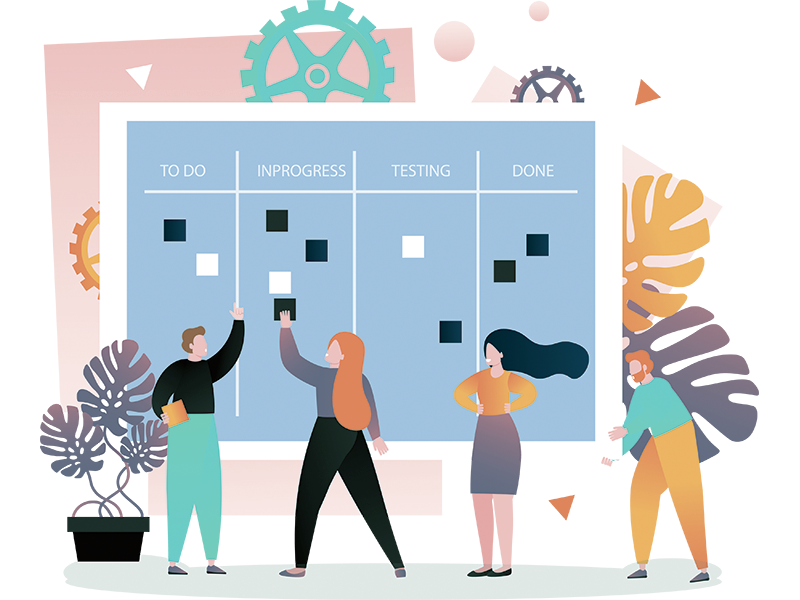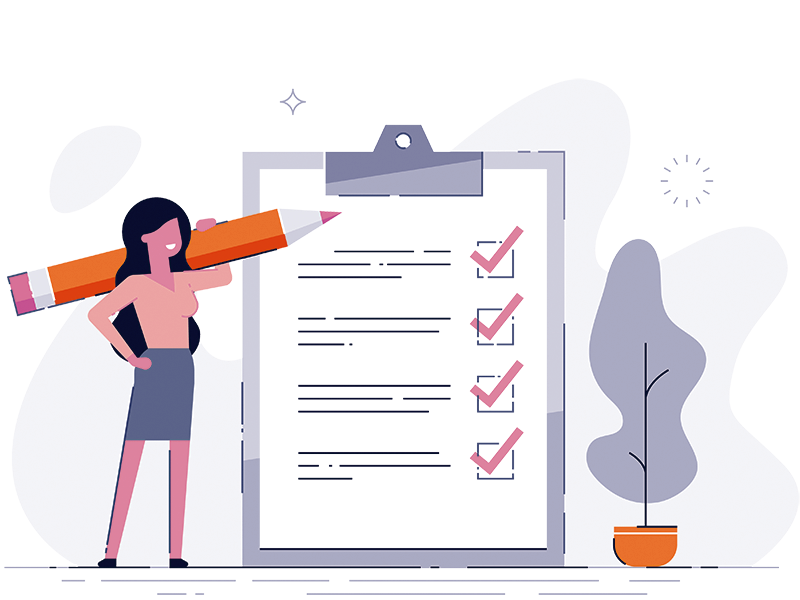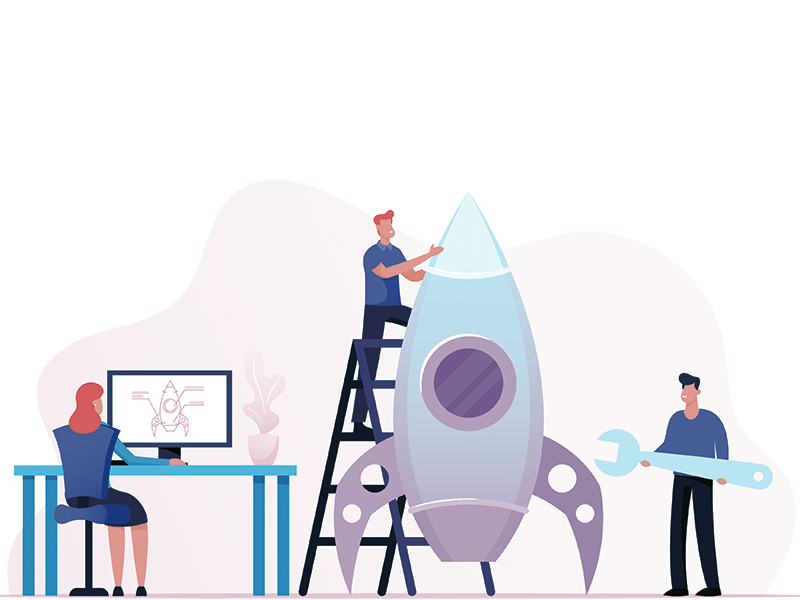
What is Idea Management?
Product Management Guide
Ideas can come from anywhere, as the saying goes – it’s what you do with those ideas that counts. In this guide, we discuss the common sources for ideas, techniques for generating those ideas, and how to manage the ideas, from soliciting feedback, to cataloging and promoting them.
What is an Idea?
An Idea is an early stage and unqualified hypothesis about something that could make our product better. Often, it is in the form of a feature request. It could also be infrastructural in nature, or an idea for how to position the product to extend its audience or make it more relevant. These ideas could come from your customers, business stakeholders, or from doing analysis on the competition, and can be collected, tagged, analyzed, clustered, and ultimately either stored for research, promoted for action as either a qualified project or backlog task, or they can be archived if they don’t make sense.
Ideation Techniques
The ideation process starts with a small set of known opportunities and background information, then explode all the possibilities onto a list, ultimately to collapsing it back down again by de-duping, qualifying, and sorting the ideas. This divergence / convergence pattern was first described by the DesignCouncil’s DoubleDiamond process for Innovation. Whatever you call it, the idea is simple – get all of the possibilities onto the table, then start looking for patterns and big opportunities that stand out, dismissing the ‘less great’ ideas after having reviewed all of the options.
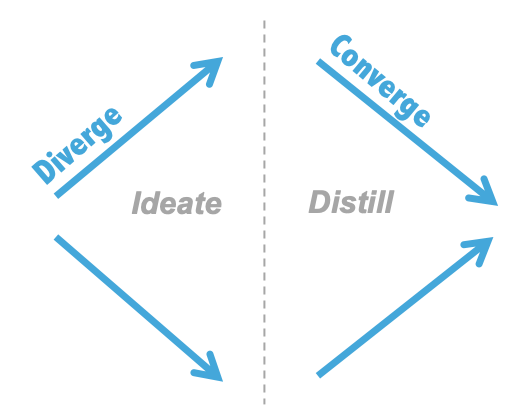
With that as context, the first step is to come up a lot of those great ideas – but how? Stepping through a structured approach can be helpful in uncovering new ideas, particularly in areas you’re not accustomed to looking. To cover the gamut, we’ve outlined 4 major perspectives to consider and provided three frameworks/techniques that can be users to identify opportunities for each of those perspectives.

Product
Vision Mapping – Start with your product’s vision statement and work backwards. What is needed to realize your 3-5 year vision for the future state of the product? What are the key features and how is it positioned or adopted? Capture each of these gaps and consider them ideas for things you could work on.
Funnel Insights – If you already have a live product, you can learn a lot by just looking at behavioral analytics, to better understand how people react to your product, where they’re engaging and where they’re dropping off. From this you can get a much better sense of what your customers want and where there may be a need to optimize your user interface. For example, perhaps you discover that your conversion funnel has an abnormal bottleneck at the checkout page – an idea could be to do an optimization project with A/B testing to reduce that friction.
Innovation Solution – your product likely solves a problem or addresses some desire for your customers – is there a new or better way to do that, which creates more value for them? Innovation can be technology, process, or simply an approach to how you convey value to the customers. It’s simply moving your frame of view, so that you look at the problem differently to ask if this is still the best way to address this need or desire for your customers. Sometimes this is something major like the Internets impact on distribution and sales, but often times it comes in the form of “micro innovations” that adds delight to your product, such as that new side impact detection feature on your car. What’s possible today, that wasn’t yesterday, and allows you to create more value for your customers?
Customer
Jobs to be Done (JTBD) – The idea here is to reframe how you think of a product, not as an inanimate object, but rather as something your customer will hire your product to do. This sounds small but is a very powerful technique for getting into the head of your customers and understanding their motivation and how to really resonate with them.
Journey Mapping – Whereas Jobs to be Done provides clarity on your customers’ “why” statement, the Customer Journey Mapping answers “how”, by breaking down the steps a customer goes through to solve their problem. This is a useful framework for putting yourself into the frame of thought of your customer at each step of their process, to ask, what do I need to accomplish this step? This can be a great way to surface new features and streamlined workflow opportunities.
Voice of Customer – when in doubt, ask your customers! It seems so obvious and yet how many busy Product Managers are regularly talking to their customers to ask what they need and want? Guided conversations, workshop games like ‘buy a feature’, card sorting, surveys, NPS, and any number of other techniques can help to structure that conversation with your customers and ask them what’s truly important to them.
Competition
Competitive SWOT – Strengths, Weaknesses, Opportunities, and Threats (SWOT) – this framework is an ‘oldie but goodie’ that can be useful for thinking through these edges of a company. It is often used internally to assess one’s own business and prepare for next years’ strategy, but why not use it to think through your competitor too?
Feature Gap Analysis – Another classic in competitive research is feature gap analysis. Start by looking at your cohort of immediate competitors and identifying the top 10-20 features that really make the difference, in terms of why a customer might choose their product over yours. Next, rate the quality of this feature on your product and for each of your competitors, in order to identify those gaps where you’re falling behind on key features. Naturally, we don’t want to just follow competitors, but. If all of your competitors have a key feature that you don’t, it becomes a “must have”, and something you cannot ignore.
Value Creation Plane – This framework asserts 2 overlaid value spectrums that create a 2×2 plane. Value capture on one side and value creation on the other. And then Entertainment above and Productivity below. Plot your competitive cohort onto this plane and look for opportunities to differentiate your offering by shifting your perceived value into another quadrant. This can be a very useful way of looking at your product through a different lens, to see transcending opportunities – feature ideas can be derived from this.
Company
Business Goals Mapping – Ideally your company’s business strategy has articulated a few key goals for the year. Take each one of those goals and work backward – what features and functionality can you implement in your product, that would drive toward achieving that goal.
Strategic Initiatives – Strategic initiatives are generally found in larger organizations and are driven from the corporate or business strategy levels. They’re generally a year or two in duration, they’re cross-functional meaning many teams are affected by them, and each of those teams then has a mandate to work with the Program Manager who is driving that initiative forward, to ensure what they need is delivered. From the Product side, that might mean a feature or integration is required. It’s important to surface these early in the planning process since they’re often mandated and can consume your resources. Check-in periodically with your business strategy and corporate strategy leaders, to get early visibility on initiatives that may be headed your way – and think about the ideas/projects that you might need to work on in support of those initiatives.
Stakeholder Requests – Lastly, take the time to listen to your stakeholders about ideas for the product. It’s not only good politics, they come up with a few pretty good ideas from time to time! For example, you might have a Sales or Marketing team who is continuously engaging customers and thus have insights about what is really important to those customers. Of course, some of those ideas may be self-serving or half-baked, but that’s okay. The important part for now is to just collect those ideas, and we can figure out how to prioritize them later.
Managing Ideas
Assuming you’ve gone through the exercises above, you should hopefully have a good list of ideas now, that have both breadth and depth. The next step is to properly catalog them so that you can properly analyze and refer back to them later.
The first thing to do is collect all of these ideas in a system like Productfolio and start tagging the ideas, accordingly to key themes. Once you have the ideas tagged, start looking for the ideas that cluster around each tag theme, removing duplicates, and making note of general patterns. You can also start archiving/removing ideas that don’t make sense, either because they’re already done or don’t fit the vision of the product.
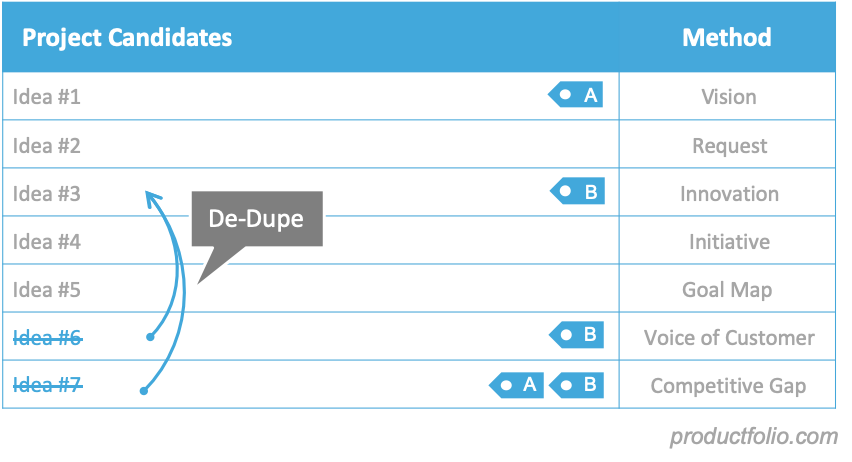
Lastly, start getting a sense of the size of these ideas – are some of these small requests that could be knocked out in a sprint? If so, you can go ahead and promote those to the backlog to prioritize in a future sprint. Or if they’re larger and something worthy of roadmap-level prioritization and planning, then promote that to your list of project candidates that you’ll put through a more rigorous evaluation and scoring process.
Conclusion
To close, Opportunity Discovery is about strategically surfacing all of the ideas to maximize the impact of your product, and then systematically distilling, organizing those ideas and promoting the best ideas for prioritization. This is the first critical step to creating a strategic product plan that maximizes the impact of your product. Too many teams don’t spend enough time on this step, despite it being core to the Product Management wheelhouse and a critical step to success.
Other Learning Guides
Product Planning
Prioritization and placement of opportunities on a roadmap provides a plan for achieving business goals and the product vision.
Product Requirements
Effective requirements is key to realizing the big ideas on the roadmap, with tangible features that solve real problems for users.
Product Development
Product plays a key role in the development of the product, whether it's Agile/Scrum, SAFe, Waterfall, or a hybrid model.
